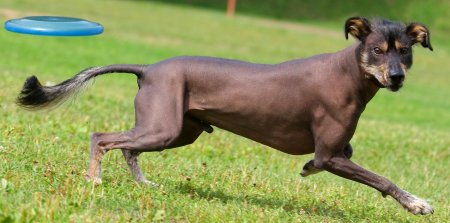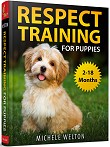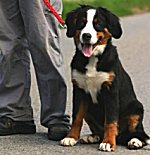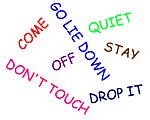Xoloitzcuintli: What's Good About 'Em, What's Bad About 'Em
Xoloitzcuintli temperament, personality, training, behavior, pros and cons, advice, and information, by Michele Welton, Dog Trainer, Behavioral Consultant, Author of 15 Dog Books

The elegant Xoloitzcuintle (sho-lo-eats-kwint-lee) is also known as the Xolo or Mexican Hairless. He comes in sizes from small to large, but the small ones are most common in the US.
This animated breed moves lightly and gracefully, runs swiftly, and jumps and climbs with agility.
His webbed toes are somewhat prehensile, allowing him to grip toys with dexterity – or your neck in an affectionate hug.
Tranquil in the home, the Xoloitzcuintli is exceptionally attentive to his owner and needs a lot of personal interaction. He is likely to pine or act out when left too long without the companionship of people or other pets.
Wary of strangers, the Xoloitzcuintli makes an alert watchdog, exceedingly aware of his surroundings. Some Xolos are high-strung and/or timid of new people and new situations. Early and frequent socialization will help build a confident, stable temperament.
Still somewhat primitive in behavior, the Xoloitzcuintle is most content with structure and consistency in his life. He often reacts based on instinct, and his reflexes are lightning fast.
Though independent, the Xolo is smart and sensitive and responds best to reward-based training with gentle corrections.
Because of his athleticism and ingenuity, your fences should be high and secure. Don't allow his barking to become established or it will be a tough habit to break.
If you want a dog who...
- Comes in sizes from small to medium
- Has an exotic, elegant appearance, like that of a small deer
- Is mostly hairless, needs no brushing, and doesn't shed
- Moves with light-footed grace, runs swiftly, and jumps and climbs with agility
- Is high-spirited, smart, and sensitive
- Makes a keen watchdog, but not a guarddog
- Is usually peaceful with other animals
A Xoloitzcuintli may be right for you.
If you don't want to deal with...
- A somewhat highstrung, emotional, dependent personality that demands much attention and will bark or act destructively when left too long without companionship
- Timidity or suspiciousness in some lines, or when not socialized enough
- Independent thinking (mind of his own)
- Emotional sensitivity to stress, loud voices, rough handling, and abrupt changes in schedule
- Tendencies to climb or dig to escape from confinement
- Barking
- Housebreaking difficulties
- Vigilant care of the hairless skin, which is sensitive to sun, cold, rain and sleet, chemicals, and hard sleeping surfaces
A Xoloitzcuintli may not be right for you.
 |
Dog Breed Traits – Which Traits Are Right For You? In this brand new series, I'll help you decide which dog breed traits would best suit you and your family, your home and yard, and your lifestyle, so you can choose the best dog breed for your family. |
Keep in mind that the inheritance of temperament is less predictable than the inheritance of physical traits such as size or shedding. Temperament and behavior are also shaped by raising and training.
FREE eBooks by Michele Welton
![]() "Respect Training for Puppies" and "Teach Your Dog 100 English Words" are free step by step guides to teaching your pup to be calm and well-behaved.
"Respect Training for Puppies" and "Teach Your Dog 100 English Words" are free step by step guides to teaching your pup to be calm and well-behaved.
![]() "11 Things You Must Do Right To Keep Your Dog Healthy and Happy" is a free guide to keeping your dog mentally, physically, and emotionally happy and healthy so you can enjoy a longer lifetime of companionship.
"11 Things You Must Do Right To Keep Your Dog Healthy and Happy" is a free guide to keeping your dog mentally, physically, and emotionally happy and healthy so you can enjoy a longer lifetime of companionship.

- You can avoid some negative traits by choosing an ADULT dog from an animal shelter or rescue group. With an adult dog, you can easily see what you're getting, and plenty of adult Xolos have already proven themselves not to have negative characteristics.
- If you want a puppy, you can avoid some negative traits by choosing the right breeder and the right puppy.
More traits and characteristics of the Xoloitzcuintli
If I was considering a Xolo, I would be most concerned about...
- Housebreaking problems. The Xoloitzcuintli is often called a "primitive" breed, meaning not too far from his wild roots. Primitive breeds are typically difficult to housebreak. Consistent crate training is mandatory. Sometimes a doggy door is necessary. And some owners never do get their Xolo fully housebroken. Territorial marking (unneutered males lifting their leg to pee in your house) is a common problem.
- Skin care. The Xolo has delicate skin that must be protected from sunburn and freezing temperatures and frequently washed and moisturized. As you might expect, naked dogs need soft blankets to curl up in.
- Separation anxiety. More than most other breeds, the Xoloitzcuintle needs a great deal of companionship and does not like being left alone for more than a few hours. Bored Xolos become anxious, which they express by destructive chewing and barking. Prospective owners of a Xoloitzcuintli should be home most of the day.
- Providing enough socialization. Standoffish by nature, the Xolo needs extensive exposure to people and to unusual sights and sounds. Otherwise his natural caution can become shyness or suspiciousness, which are difficult to live with.
- Emotional sensitivity. Be honest.... is there tension in your home? Are people loud or angry or emotional? The Xoloitzcuintli is extremely sensitive to stress and can end up with digestive upsets and neurotic behaviors if the people in their home are having family problems. Xolos are peaceful dogs who need a harmonious home.
- Fence security. Many Xolos climb like monkeys and dig like gophers. You may need higher fences than you might imagine for their small size. You may also need to sink wire into the ground along the fence line to thwart digging.
- Mind of his own. Xolos are clever dogs, but intelligence doesn't necessarily translate into obedience. In fact, Xolos have an independent mind of their own and are inclined to use their cleverness in rather manipulative ways, trying to wheedle you into doing what they want. You must show them, through absolute consistency, that you mean what you say.
In other words, you must teach your Xolo to respect you. A dog who respects you will do what you say and will stop what he's doing when you tell him "No." Follow my free online training programs.
- Barking. Xolos are often too quick to sound the alarm at every new sight and sound. You have to be equally quick to stop them.
My best-selling books – now available FREE on my website
 Respect Training For Puppies: 30 seconds to a calm, polite, well-behaved puppy is for puppies 2 to 18 months old. Your puppy will learn the 21 skills that all family dogs need to know. Click here to read for free.
Respect Training For Puppies: 30 seconds to a calm, polite, well-behaved puppy is for puppies 2 to 18 months old. Your puppy will learn the 21 skills that all family dogs need to know. Click here to read for free. Teach Your Dog 100 English Words is a unique Vocabulary and Respect Training Program that will teach your adult dog to listen to you and do what you say. Click here to read for free.
Teach Your Dog 100 English Words is a unique Vocabulary and Respect Training Program that will teach your adult dog to listen to you and do what you say. Click here to read for free. 11 Things You Must Do Right To Keep Your Dog Healthy and Happy helps your dog live a longer, healthier life. Get my honest advice about all 11 Things before you bring home your new puppy, because some mistakes with early health care cannot be undone. Click here to read for free.
11 Things You Must Do Right To Keep Your Dog Healthy and Happy helps your dog live a longer, healthier life. Get my honest advice about all 11 Things before you bring home your new puppy, because some mistakes with early health care cannot be undone. Click here to read for free.Related posts you might enjoy






